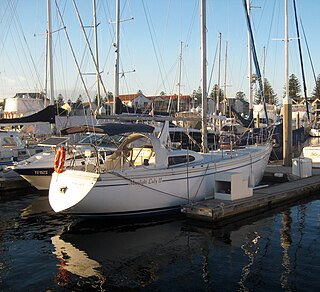Bruce Kenneth Farr is a New Zealand designer of racing and cruising yachts. Farr‑designed boats have won, challenged for, or placed highly in the Whitbread Round the World Race, America's Cup, and Sydney to Hobart Yacht Race, among others.
Hinckley Yachts, founded in 1928, manufactures, services and sells luxury sail and powerboats. The company is based in Maine, United States. The company has developed yacht technologies including JetStick and Dual Guard composite material, and was an early developer of the fiberglass hull. Currently, Hinckley operates service yards in seven locations along the east coast of the United States, making it one of the most integrated boating concerns in the United States. Hinckley’s present yacht line includes boats ranging in size from 29 to 55 feet. All of Hinckley’s yachts are built to order with customization of the interior and exterior cosmetics as required by the purchaser.

William Ion Belton Crealock was a yacht designer and author. He was one of the world's leading yacht designers from the 1960s through the 1990s, and his yachts were owned by the famous and wealthy, including Walter Cronkite and William Hurt.
Cascade Yachts was a pioneering U.S.-based builder of fiberglass monohull sloop-rigged sailboats ranging in sizes from 23 to 42 feet (13 m) in length. It was founded in 1954 in Portland, Oregon by a group of local sailors interested in experimenting with fiberglass sailboat construction.
The Landfall 35 is a sailboat, that was designed by Robert W. Ball, the chief designer of C&C Design, and first built in 1979. The Landfall series was part of a trend within C&C Yachts to develop more cruising-oriented designs under company president George Cuthbertson's direction during the later 1970s and early 1980s.
The Catalina 375 is an American sailboat that was designed by Gerry Douglas as a cruiser and first built in 2008.

The Columbia 34 Mark II is an American sailboat that was designed by William H. Tripp Jr. as a coastal cruising sailboat and first built in 1970.
Mark Ellis is an American-Canadian naval architect, who has designed sixteen production sailboats, along with many custom sailboats and powerboats. He is best known for his Nonsuch series of catboats, the Limestone series of powerboats and Niagara sailboats. In 2003, Dan Spurr described Ellis as "one of Canada's premier yacht designers".
The Vancouver 36 is an American sailboat that was designed by Robert B. Harris as a bluewater ocean cruiser and first built in 1977.
The Hinterhoeller F3 is a Canadian sailboat that was designed by Argentine naval architect Germán Frers as a racer-cruiser and first built in 1981.
The Crealock 37, also called the Pacific Seacraft 37, is an American sailboat that was designed by British naval architect W. I. B. Crealock as a cruiser and first built in 1978.
The Endeavour 40 is an American sailboat that was designed by Robert K. Johnson as a cruiser and first built in 1981.
The Endeavour Yacht Corporation was an American boat builder based in Largo, Florida. Founded in 1974 by John Brooks and Rob Valdes, the company specialized in the design and manufacture of fiberglass sailboats. The company went out of business in 1986.
Irwin Yacht and Marine Corporation, often just called Irwin Yachts, was an American boat builder based in St. Petersburg, Florida. The company specialized in the design and manufacture of fiberglass sailboats and became one of the largest producers of sailboats in the United States.
The Fisher 25 or Fisher 25 MS is a British trailerable pilothouse sailboat that was designed by Wyatt and Freeman as a cruiser and first built in 1974.
The Lancer Yacht Corporation was an American boat builder based in Irvine, California. The company specialized in the design and manufacture of fiberglass sailboats.
The MacGregor 19, also called the PowerSailer 19, is an American trailerable sailboat that was designed by Roger MacGregor as a cruiser and first built in 1992.
Lyle C. Hess (1912–2002) was an American naval architect, particularly known for his Aquarius and Balboa series of boats, built by Coastal Recreation.
The S2 7.0 is an American trailerable sailboat that was designed by Arthur Edmunds as a cruiser and first built in 1975. The designation indicates the approximate length overall in meters.



